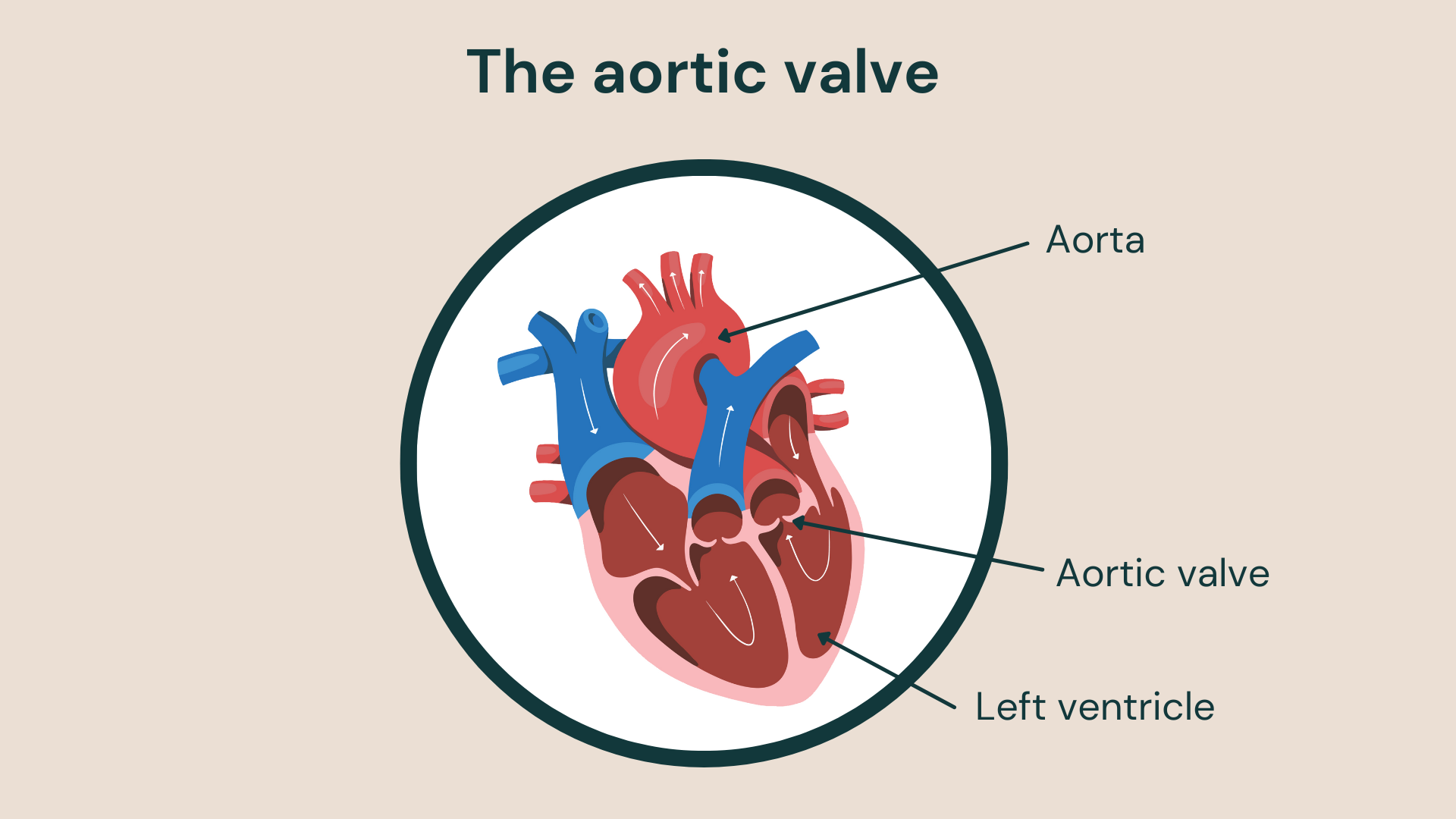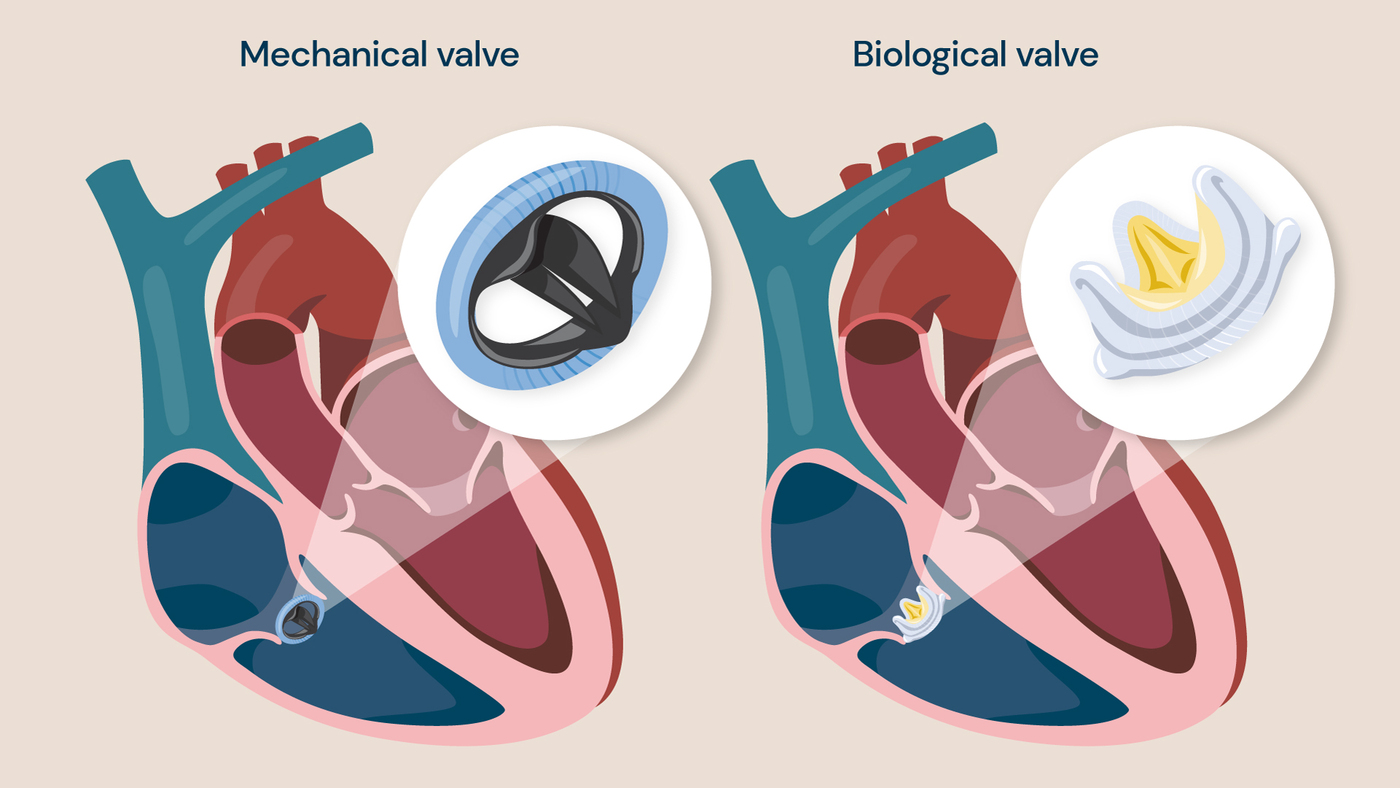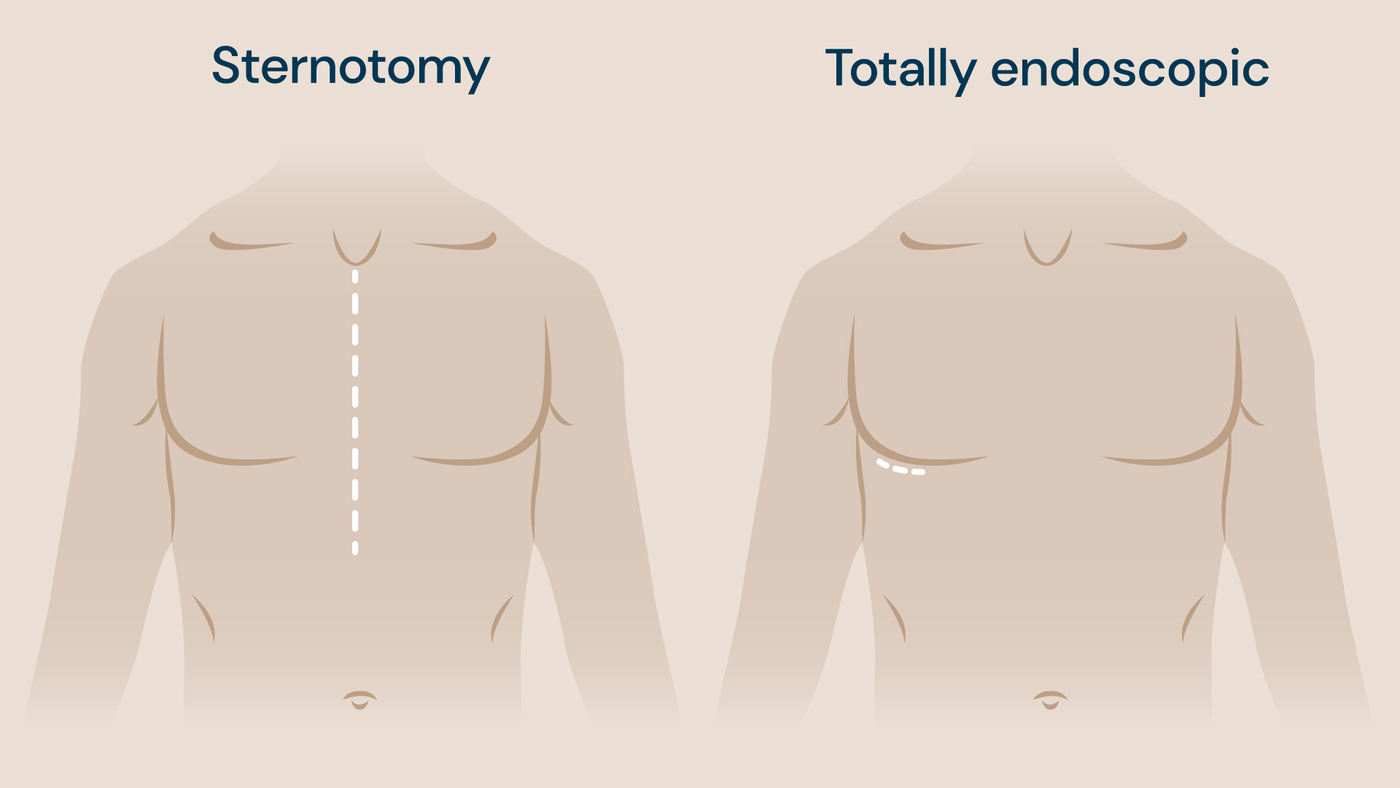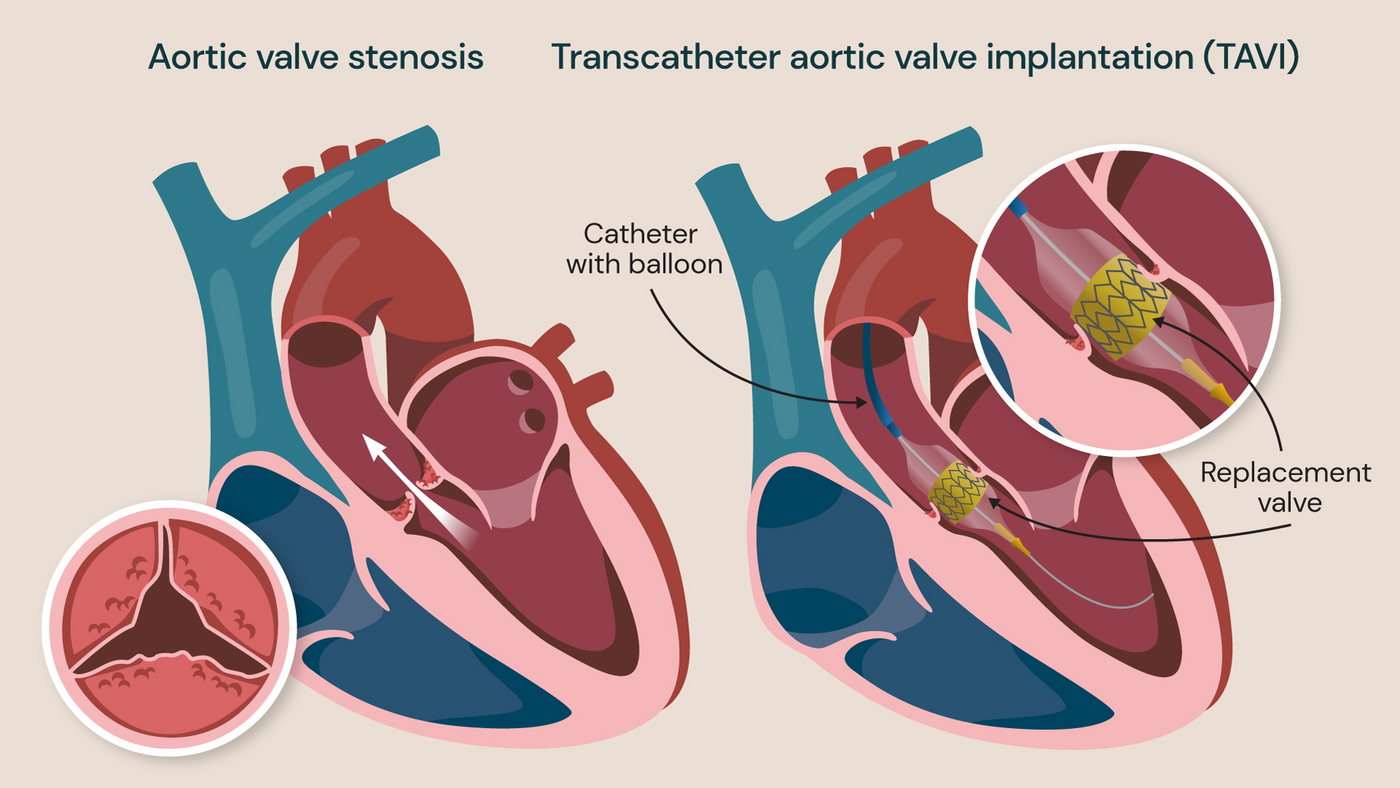What is the aortic valve?
The aortic valve in your heart ensures your blood flows in the correct direction. The valve is located between the left ventricle (main chamber of the heart) and aorta (the largest blood vessel of the body). Aortic valve repair or replacement may be needed if the valve becomes diseased and doesn’t work as it should.

The aortic valve ensures that blood flows in the right direction from the heart to the rest of the body.
What is aortic valve disease?
Aortic valve disease is a condition that impacts the aortic valves of your heart and prevents them from working properly. Symptoms of the condition can include shortness of breath, chest pain, feeling faint and fatigue.
Aortic valve disease can present in different forms:
- Aortic valve stenosis occurs when the aortic valve becomes stiff and/or narrow. This prevents blood from flowing as it should from the left ventricle to the aorta.
- Aortic valve regurgitation occurs when the leaflets of the aortic valve can’t close fully. This causes blood to flow backwards into the heart.
Aortic valve disease can be present at birth (congenital heart disease) or appear later in life.
When lifestyle changes and medications do not improve symptoms, an aortic valve repair or replacement procedure may be recommended.
Treatment for aortic valve disease
Aortic valve repair and replacement procedures are both used to treat aortic valve disease. The decision to repair or replace your damaged aortic valve depends on various factors, including your age, severity (stage) of disease and your overall health.
At Royal Brompton and Harefield hospitals, our specialists can provide minimally invasive surgical and non-surgical treatment options, in addition to open-heart surgery. Your doctor will recommend the best treatment option based on your state of health, age and other factors.
What is an aortic valve repair?
Aortic valve repair can be an option for patients suffering from aortic regurgitation.
Our heart specialists may perform an open-heart or minimally invasive procedure to repair your aortic valve.
To repair your aortic valve, a specialist may:
- seal holes or tears in the valve leaflets
- add support at the root or base of the valve
- separate valve leaflets that have fused together
- repair the leaflets
- strengthen or tighten the ring around the valve
What is an aortic valve replacement?
If your aortic valve disease is severe, an aortic valve replacement may be recommended.
An aortic valve replacement is where a faulty or damaged valve is replaced with one that is mechanical (made from synthetic materials) or made from biological tissues.

Your doctor will recommend which type of valve is best for you.
A mechanical valve lasts longer but will need you to take blood-thinning medications (anticoagulants) for life. Biological valves (either human or animal) do not require you to take anticoagulants but last 10 to 15 years, meaning that you may need the valve to be replaced later in life. However, newly available valves may last longer.
Aortic valve replacement can be performed as an open-heart surgical procedure or with minimally invasive techniques. Your doctor will recommend the best procedure based on your condition, your health and other factors.
Open-heart aortic valve replacement
Valve-sparing aortic root replacement (David procedure)
A healthy aortic valve normally closes after blood in pumped out of the heart, to prevent the backflow of blood. In patients with aortic root aneurysms, the aortic valve stretches and cannot fully close.
In patients with aortic root aneurysm who maintain a healthy valve, the David procedure may be suitable. The procedure spares the healthy aortic valve, by replacing the weakened section of the ascending aorta, removing the stretching pressure and allowing it to return to normal function.
The Ross procedure
For severe heart valve disease, the non-functioning valve must be replaced. For younger patients, the Ross procedure may be recommended.
The Ross procedure involves replacing a non-functioning aortic valve with your pulmonary valve and then implanting a healthy donor valve where your pulmonary valve used to be.
This offers patients a similar quality of life to those without heart disease and can last approximately 20 years.
Sutureless aortic valve replacement
With conventional aortic valve replacement, the diseased valve is removed from your heart before sewing in the new valve. However, the surgery can also be performed with sutureless aortic valve replacement, meaning that the replacement valve will not need to be sewn into place, and therefore no stitches are used. This reduces surgery time and enhances recovery as the surgery becomes less invasive.
Sutureless aortic valve replacement is also often recommended if you have severe aortic valve stenosis and have a higher likelihood of complications.
Minimally invasive aortic valve repair and replacement
In conventional aortic valve replacement surgery, the procedure is usually performed through an incision made through the length of the breastbone.
However, minimally invasive aortic valve replacement surgery allows the replacement to be done through a smaller incision, (5-7 cm) in the upper part of your breastbone, or between your ribs.
The use of a smaller incision may help to:
- reduce pain
- reduce the risk of wound infection
- lower the time spent in the hospital after the operation
- reduced bleeding
- reduce scarring with an improved cosmetic result
Our consultants at Royal Brompton and Harefield hospitals are internationally recognised in minimally invasive aortic valve repair and replacement, including the pioneering of new techniques. Explore our procedures below.
Endoscopic (keyhole) aortic valve repair and replacement
Our specialist heart surgeons at Royal Brompton and Harefield hospitals have developed a new endoscopic (keyhole) technique to repair or replace a damaged aortic valve. This pioneering treatment offers an alternative to invasive open-heart surgery (where the breastbone is cut).

A single incision is made between the ribs to access and perform surgery on the heart.
During the procedure, a small 2.5cm incision is made between the ribs to place an endoscope (a thin flexible tube with a camera at the end) to access the heart.
The procedure is completed in about 4 hours utilising high-definition 3D camera technology to direct surgery in your heart. It has also been shown by studies that this procedure is just as safe.
A keyhole aortic valve repair or replacement can enhance recovery time while reducing the size of the surgical scar when compared to traditional open-heart surgery.
Patients can normally leave hospital in around four days after surgery, returning to normal activities (such as driving) within three weeks after surgery. Traditional open-heart surgery has a longer recovery period, with patients returning to normal activities after three months.
Our consultant cardiac surgeons have performed minimally invasive heart procedures almost 1,000 times at our hospitals, making them very experienced.
Transcatheter aortic valve implantation (TAVI)
Aortic valve replacement can also be done using minimally invasive non-surgical techniques, such as transcatheter aortic valve implantation (TAVI). TAVI is a minimally invasive procedure and is where a new aortic valve is inserted without removing the damaged one. Instead, the new valve is placed inside the old one — compressing the old one and taking over its function within your body. It is used to treat aortic stenosis.

The TAVI procedure is a minimally invasive procedure where the new aortic valve is inserted without removing the damaged one.
TAVI is performed under local anaesthetic and uses a catheter – a tube-like device – that is directed to your heart with X-ray video via a small incision in your groin or shoulder. If the damaged valve is narrow, a balloon is used to gently inflate it so the new one can be fed through.
It is particularly suited to patients that are high-risk for aortic valve replacement surgery, such as if they are older or have other health issues which make surgery challenging.
Occasionally, TAVI can be performed for aortic valve regurgitation if patients are too high-risk for surgery. However, this is an off-label indication for the treatment and your doctor will explain the risks and benefits of this approach if it is considered.
Balloon valvuloplasty for aortic valve stenosis
Balloon valvuloplasty is a minimally invasive procedure, usually recommended for older and paediatric patients, that is delivered via a catheter – a tube-like device. The catheter is directed to the aortic valve of the heart with medical imaging via a blood vessel in the groin.
When the balloon is at the location of the narrow aortic valve, it is inflated to widen it, before being deflated and removed. This procedure can treat aortic valve stenosis.
How to prepare for aortic valve repair or replacement
Preparing for your aortic valve procedure is important. Your doctor will let you know exactly what you need to do beforehand.
Preparation advice from your doctor may include:
- stopping smoking
- weight-loss
- living a healthy lifestyle
In the days leading up to your surgery, you may need to:
- stop certain medications that you regularly take
- not eat or drink for a specified amount of time before your procedure
- advise your healthcare team of any allergies you have
You may also be asked to remove any contact lenses, dentures, nail polish or jewellery before the procedure.
Aortic valve repair or replacement recovery
After you have an aortic valve repair or replacement procedure, you will need to remain in the hospital for a short period to get your recovery off to a good start.
The time it takes for you to fully recover will depend on the procedure you have, taking up to three months with open-heart surgery. However, this can be reduced if you have a minimally invasive procedure or TAVI and are in good health.
When you return home after your procedure, you will need to take good care of your health to help your recovery. This means you may need to wait at least six weeks before driving, having sex, or returning to work. You will also need to avoid strenuous exercise for at least three months.
During your recovery, you must eat a well-balanced diet, limit your stress levels and avoid smoking. Lifestyle changes like these can not only help you maintain a healthy heart after the replacement, but also prevent further damage.
Risks of an aortic valve replacement
Some of the main risks and complications associated with aortic valve repair or replacement can include:
- infection
- blood clots
- bleeding
- failure of the replacement valve
- arrhythmias
- stroke
Every surgery carries with it potential risks. However, when you have your aortic valve repair or replacement performed at specialist heart hospitals like Royal Brompton and Harefield, these risks can be greatly reduced.
Related services
-
Aortic valve repair and replacement
An aortic valve repair or replacement procedure treats a damaged aortic valve in your heart to enhance blood flow.
-
Cardiac MRI scan (CMR)
A cardiac magnetic resonance (CMR) scan is non-invasive and shows detailed images of your heart.
-
Diagnostic tests for heart conditions
We offer a range of diagnostic tests at our state-of-the-art facilities.
-
Echocardiogram
An echocardiogram – also known as an echo – is a scan that examines the heart and surrounding blood vessels.
-
Electrocardiogram (ECG)
An electrocardiogram (also known as an ECG) is a test which is used to check your heart’s rhythm and electrical activity.
-
Heart valve repair or replacement
Heart valve surgery can repair or replace a damaged valve.
-
Mitral valve repair and replacement
Mitral valve repair and replacement surgeries are used to fix problems with your mitral valve. Discover more about these surgeries.
-
Tricuspid valve repair and replacement
Damaged tricuspid valves are treated using either a tricuspid valve repair or replacement procedure. Discover more about these innovative treatments.
Locations
Explore our team of cardiology and cardiac surgery specialists
Meet our team of world renowned cardiology and cardiac surgery specialists. From cardiovascular health assessments to innovative interventions, our experts are committed to delivering personalised care designed just for you.
